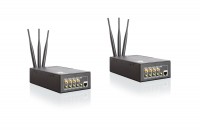Bonding instead of load balancing: Never be offline again!
Viprinet – Always online, always broadband!
Today, business transactions require enterprises to have an Internet connection with 100% uptime. However, most network solutions dash already against the basics: As soon as an Internet line drops out and mobile radio cells are overbooked, the availability of the connectivity solution decreases significantly. Learn in this video why Viprinet is independent of individual Internet links and can thus help businesses to achieve 100% uptime – at even lower costs.
Feel free to visit our downloads section and download our whitepaper on the topic "Always online – wherever and whenever needed", providing detailed information on the Viprinet principle and its possibilities.
We invented integrated hardware and SD-WAN bonding
We invented the principle of enabling the bonding of different types of internet connections using SD-WAN. For us, bonding means real aggregation of bandwidth of all WAN media to be bonded.
The Multichannel VPN Router is the core of the Viprinet technology. With this device, several broadband lines can be combined into a single, highly available joint line. Unlike load balancing which can only distribute load to several WAN links, real bonding of all connections available is realized here.
Viprinet can combine all different types of access media, be they ADSL, SDSL, UMTS / HSPA+ / 3G, or LTE / 4G. The LAN sees these connections as one single line providing the accumulated up- and downstream of the different links even for single downloads.
The remote station principle
Viprinet uses an exceptional SD-WAN based VPN tunnel technique with a star topology for secure and fast site, facility and vehicle linkage. For this purpose, the integration of two different devices is needed: A Multichannel VPN Router establishes an encrypted VPN tunnel to a single central remote station, the Multichannel VPN Hub, via each Internet line available. These VPN tunnels are then bundled into one tunnel through which the data is then transferred.
The Multichannel VPN Hub is usually located in a highly reliable data center and acts as an exchange: Data targeted at another company site will be forwarded through the respective VPN tunnel; data targeted at the public Internet will be decrypted and forwarded to its destination. The VPN Hub provides secure and quick communication between different Multichannel VPN Routers but it also serves as pivotal exchange point between the encrypted VPN and the public Internet.

Highest reliability and maximum bandwidth
With bonding using the Viprinet principle, a fast virtual WAN connection featuring almost 100 per cent reliability can be established. This reliability even inceases, the more different WAN media are bonded together. The ability to aggregate the bandwidths of all WAN media guarantees maximum transfer rates.
Wired and wireless bonding: Viprinet's magic
The magic of the Viprinet principle lies in bonding wired WAN media like DSL or cable together with wireless media like UMTS / 3G, HSPA+ or even LTE / 4G, using SD-WAN. Providers able to bond all these media always offer the optimum mix of cost-effective WAN media ensuring highest bandwidth and reliability. Especially the ability to combine all common 3G and 4G mobile phone technologies like LTE, HSPA+, UMTS and CDMA via bonding with satellite and/or DSL or cable is unique worldwide.







